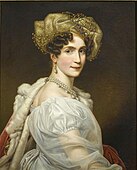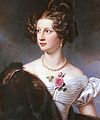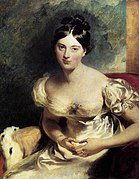In France, the nobility brought back the style of the Bourbon dynasty, which is called the style restoration. Paris remains the capital of luxury. But the state of finances does not allow for large expenses. Elsewhere in continental Europe, the Biedermeier style blooming.
The corset reappears and the skirt adopts the shape of a cone. The sleeves become more puffy and to make them even larger, they are doubled with cardboard, which has the advantage of making the size even thinner. Under Charles X (1825-1830), the skirts shorten the ankle and gain in volume. The hats take gigantic proportions, covered with feathers and ribbons. In the evening, the women are combing in height of a bun said in knot of Apollohairpiece maintained in balance by a large Spanish-style comb. Romanticism influences women's fashion.
As a pretext for feminine dress, men's fashion is always inspired by English chic: sober colors and shapes. The pants, legacy of the Revolution, is usually worn and the pants are abandoned little by little. One wears large capes and the top hat becomes the indispensable accessory of every self-respecting man until the First World War.
Women's fashions
Overview
During the first half of the 1820s, there were slight gradual modifications of Regency styles, with the position of the waistline trending successively lower than the high waistline of the Regency (just below the breasts), and also further development of the trends of the late 1810s towards giving skirts a somewhat conical silhouette (as opposed to earlier more clinging and free-flowing styles), and in having various types of decoration (sometimes large and ornate) applied horizontally around the dress near the hem. Sleeves also began increasing in size, foreshadowing the styles of the 1830s. However, there was still no radical break with the Empire/Regency aesthetic. Skirts became even wider at the bottom during the 1820s, with more ornamentation and definition toward the bottom of the skirt such as tucks, pleats, ruffles, or loops of silk or fur.
During the second half of the 1820s, this neoclassical aesthetic was decisively repudiated, preparing the way for the main fashion features of the next ten to fifteen years (large sleeves, somewhat strict corseting of the natural waist, full skirts, elaborate large-circumference hats, and visual emphasis on wide sloping shoulders). Rich colors such as chrome yellow and Turkey red became popular, and fabrics with large bold checkerboard or plaid patterns became fashionable, (another contrast with the previous fashion period, which had favored small delicate pastel prints). A bustle was sometimes also worn. Belts accentuated the new defined waist.
Dresses were often worn with a round ruffled linen collar similar to a soft Elizabethan ruff.
Hairstyles and headgear
Early in the decade, hair was parted in the center front and styled into tight curls over the temples. As the decade progressed, these curls became more elaborate and expansive. The bun on the back became a looped knot worn high on top of the head. Wide-brimmed hats and hat-like bonnets with masses of feathers and ribbon trims were worn by mid-decade.
Conservative married or older women wore indoor caps of fine linen descended from the earlier mob cap; these had a pleated or gathered caul on the back to cover the hair, and a narrow brim at the front that widened to cover the ears and often tied under the chin. These caps were worn under bonnets for street-wear.
Women also began to wear caps known as a cornette around 1816. These caps were tied under the chin and worn indoors. They also tended to be greatly adorned with plumes, ribbons, flowers, and jewels. Another alternative to the cornette was the turban, also often bejeweled and adorned, which shows the great interest in exotic cultures.
 |  |  |  |  |
|---|
Outerwear
Shawls remained popular. Cloaks and full-length coats were worn in cold or wet weather.
Shoes
The fashionable shoe was a flat slipper. In the late 1820s, the first high shoe appeared and became vogue for both men and women. The shoe typically consisted of a three-inch high cloth top that laced on the inner side and a leather vamp that supported a long, narrow, and squared toe.
Style gallery 1820–25

1 – 1821
| 
2 – 1822
| 
3 – 1823
| 
4 – 1823
| 
5 – 1824
|
|---|---|---|---|---|

6 – 1824
| 
7 - 1824
| 
8 – 1825
|
1.Mademoiselle Gonin wears a dark dress with small puffed sleeves, with a ruffled collar and a blue plaid ribbon at the neck. Her hair is styled into small curls at her temples.
2.Collette Versavel's blue dress of 1822 is slightly cone-shaped, and is trimmed with frills around the hem. She carries a deep red shawl with a paisley patterned border.
3.Antonietta Vitali Sola wears an arrangement of tight, vertical curls at her temples. Her sheer chemise or chemisette has a double ruffled collar, 1823.
4.Evening gown of 1823 has a sheer overskirt.
5.Fashion plate of a "carriage" or travelling dress of 1824 has fur trim and a matching muff. Note lower waist, fuller sleeves, and wider skirt.
6.Marchesa Marianna Florenzi wears a fur-trimmed dress with a belt over a white ruffled undergown and carries a feather-trimmed bonnet, 1824
7.This young lady wears a red gown with a satin waistband, accessorized with a paisley shawl, 1824.
8.The Duchess de Berry's fashion-forward gown of 1825 shows the wide waistband that was gradually lowering waistlines. Her fitted bodice and prominent headdress would be important styles for the next several years.
Style gallery 1826–29

1 – 1824
| 
2 – 1826
| 
3 – 1825–30
| 
4 – 1827
| 
5 – 1827
|
|---|---|---|---|---|

6 - 1827
| 
7 - 1827
| 
8 – 1828
| 
9 – 1829
| 
10 - 1829
|
1.Madame Marie Marcotte wears a brown gown with a wide buckled belt, full sleeves, and a sheer collar with shell buttons. Her hair is worn in elaborate curls on the sides and on top. 1826.
2.Viennese fashion plate of 1826. Stripes run in different directions on the skirt, hem and sleeves, and the hat is lined with plaid fabric and trimmed with a matching ribbon.
3.Comtesse de MacMahon wears a satin dress with a conical skirt trimmed with horizontal frills at the hem. Matching frills accent the new wide-puffed sleeves. She wears a large hat decorated with ostrich plumes, latter half of the 1820s.
4.Auguste Strobl wears a sheer overdress with full sleeves in the new fashion over a white gown with short puffed undersleeves. A wide ribbon sash is fastened with a gold buckle. German, 1827.
5.Sarah Stanton Blake wears a frilled indoor cap trimmed with sheer ribbon and a high-necked chemise or chemisette under her black dress and scarlet shawl. Massachusetts, c. 1827.
6.Dress of silk and cotton gauze, dyed chrome yellow and block printed with a chinoiserie pattern, Europe, c. 1827. Los Angeles County Museum of Art, M.2007.211.937.
7.Fashion poster with 1827 hats.
8.Evening gown of Amalie von Krüdener in 1828 shows the beginnings of the dropped shoulder and wide sleeve puff that would flower in the 1830s. Hair is worn in elaborate side curls, and the knotted bun is higher on the crown of the head. German.
9.Regina Daxenberger wears sheer blue oversleeves with short puffed undersleeves.
10.Fashion plate shows "Newest Fashions for May 1829: Morning and Evening Dresses
Regency style fashion 1820-1830

1-1820s
| 
2-1822
| 
3-1824–25
| 
4-1828
|
|---|
1. Sarah Siddons's daughter Sally. Painting by Thomas Lawrence, eighteenth century.
2.Portrait of Marguerite, Countess of Blessington, 1822, Wallace Collection, London
3.Lady Maria Conyngham, 1824–25, Metropolitan Museum of Art
4.Portrait of the Honorable Mrs. Seymour Bathurst, 1828, Dallas Museum of Art
Source from Wikipedia
没有评论:
发表评论